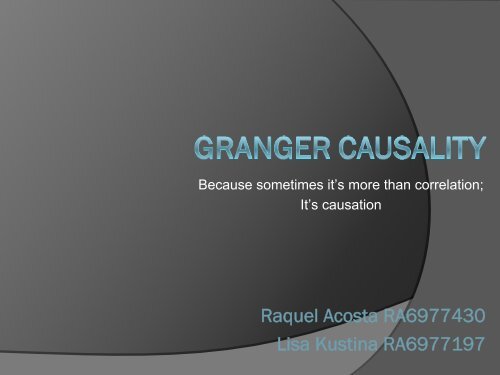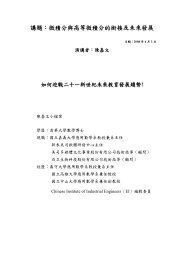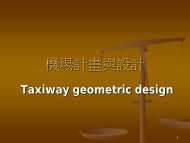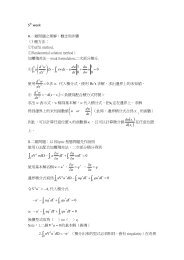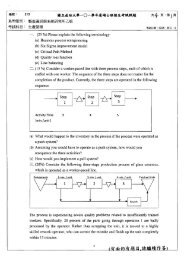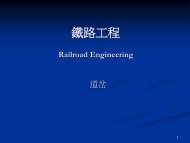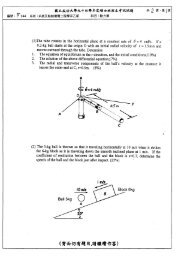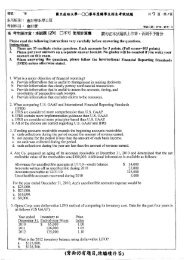Granger-causality tests
Granger-causality tests
Granger-causality tests
You also want an ePaper? Increase the reach of your titles
YUMPU automatically turns print PDFs into web optimized ePapers that Google loves.
Because sometimes it’s more than correlation;<br />
It’s causation<br />
Raquel Acosta RA6977430<br />
Lisa Kustina RA6977197
Used to determine if one time series is<br />
useful in forecasting another<br />
Claims to move beyond correlation to<br />
test for causation<br />
Can only be applied to pairs of variables<br />
May be misleading if true relationship<br />
involves three or more variables
What is <strong>causality</strong>?<br />
What do you think?
Sir Clive William John <strong>Granger</strong><br />
•Born 1943<br />
•Studied applied mathematics and<br />
statistics<br />
•Won Nobel Prize in Economics 2003<br />
•Published a series of articles and<br />
two books analyzing the relationship<br />
between time series<br />
The topic of how to define <strong>causality</strong> has kept philosophers busy for over two thousand years and has yet to be<br />
resolved. It is a deep convoluted question with many possible answers which do not satisfy everyone, and yet it<br />
remains of some importance. Investigators would like to think that they have found a “cause”, which is a deep<br />
fundamental relationship and possibly potentially useful…
Sir Clive William John <strong>Granger</strong><br />
•Born in 1943<br />
•Studied applied mathematics and<br />
statistics<br />
•Won Nobel Prize in Economics 2003<br />
•Published a series of articles and<br />
two books analyzing the relationship<br />
between time series
What is <strong>causality</strong>?<br />
<br />
is all the information in the universe<br />
at time T<br />
F(A|B) is the conditional distribution of A<br />
given B<br />
and are two time series<br />
If this condition holds, then does not cause .<br />
If this condition does not hold, then can be<br />
said to cause because it contains special<br />
information that is not available elsewhere.
1. Run a regression of X<br />
2. Determine a statistically significant time lag<br />
interval<br />
3. Run multiple regressions<br />
1. Make sure additional regressions are also significant<br />
2. Include regressions that add explanatory power<br />
4. Can be repeated for multiple Ys<br />
5. Hopefully, find a clear relationship, such as Y<br />
granger-causes X
Do a series of F-<strong>tests</strong> on lagged values<br />
of Y to see if those values provide<br />
statistically significant information about<br />
future values of X<br />
Can involve more variables if vector<br />
autoregression is applied to capture<br />
interdependencies
Linear Regression models<br />
<br />
Used to describe the dependence of the mean value of one variable<br />
on one or more other variables.<br />
E(Y | x) – the regression of Y on x.<br />
• x is the explanatory variable, or regressor. Y – the mean of variable y.<br />
○<br />
i.e. (y is the occurrences of embezzlement and x is the individuals yearly income)<br />
• Since it’s linear E(Y|x) – β 0 +β 1 x<br />
○<br />
β are our regression coefficents.<br />
○ Y is of unknown variance σ 2<br />
○ Given a sample of n independent pairs of observations (x i<br />
, y i<br />
) the best estimators of β 0<br />
+β 1<br />
is given by the method of Least Squares.<br />
• i.e. minimize Σ(y i - β 0 - β 1 x 1 )<br />
• Gauss-Markov theorem states that the least squares estimator gives the unbiased* estimator of a<br />
parameter having minimum variance.<br />
• It’s good to note the least-squares regression of x on y is not in general the same line as the leastsquares<br />
regression of y on x. – i.e. what is meant by the line of best fit to a data set depends on what<br />
assumptions are made about the nature of any deviations from a fitted line<br />
<br />
Goal – select parameters so as to minimize the sum of the squared residuals<br />
• OLS – Ordinary least squares estimation<br />
○ Best linear unbiased estimates if and only if the Gauss-Markov assumptions are satisfied.
Time series models<br />
Standard regression can’t be applied<br />
Common forms<br />
• Autoregressive models<br />
• Moving average models<br />
• Box-Jenkins (Combines these 2)<br />
• ARCH - Autoregressive conditional heteroskedasticity<br />
• GARCH – Generalized ARCH<br />
○ Frequently used for financial time series<br />
• VAR – Vector autoregression<br />
○ Used to understand inter-relationships of variables represented by<br />
systems of equations<br />
Estimates difference equations containing<br />
stochastic components
Autoregressive model<br />
X t = c + φX t-1 + ε t where ε t is white noise with zero<br />
mean and variance σ 2<br />
○ If φ = 1 then X t exhibits a unit root and can be<br />
considered a random walk.<br />
○ For AR of order 1, processes where its parameters φ,<br />
are stationary if φ < 1.<br />
• Let μ be the mean. Then E(X t ) = E(c) + φ E(φX t-1 )<br />
+ E(ε t ) ; so μ = c + φ μ+0<br />
• So var(X t ) = E(X t 2 ) – μ 2 = σ 2 /(1- φ 2 )<br />
• Autocovariance is given by E(X t+n | X t ) - μ 2 =(σ 2 /(1-<br />
φ 2 )) φ |n|
Tools<br />
Correlation coefficient<br />
• Product moment CC<br />
○ Pearson CC<br />
○<br />
○<br />
For straight line relationship ρ is plus or minus one<br />
If ρ = 0, X and Y are uncorrelated<br />
• Doesn’t imply independence unless X and Y have a bivariate distribution<br />
○ i.e. for n paired observations the sample correlation coefficient is r = S xy<br />
/(S xx<br />
S yy<br />
) 1/2<br />
• S xy<br />
is the sum of the products of deviations of x i<br />
and y i<br />
from their means<br />
• S xx<br />
and S yy<br />
are the sums of squares of deviations from their means<br />
• r =1 implies a direct relationship, r = -1 implies an inverse one<br />
• r = 0 implies virtually no linear relationship, but there may be some other association<br />
- i.e. Points scattered around the circumference of a circle<br />
• Spearman CC<br />
○<br />
2 sets of paired ranks<br />
• Kendall CC<br />
○<br />
2 sets of orderings of the same objects<br />
• Biserial CC<br />
○<br />
y may only take one of 2 variables
Tools (Continued)<br />
F – <strong>tests</strong> (F distribution)<br />
• Used in analysis of variance to test the Null hypothesis that 2<br />
components estimate the same variance against the alternative<br />
that the numerator estimates a greater variance, the latter<br />
indicating a high “F-value”.<br />
• May also be used to test the acceptability that 2 samples are from<br />
normal distributions with the same variance<br />
• i.e. the ratio of explained variance vs. unexplained variance, OR<br />
between group variability vs. within group variability<br />
Variance ratio<br />
• The ratio of 2 estimates of variance with degrees<br />
of freedom f 1<br />
and f 2<br />
.<br />
• If they both estimate the same variance the ratio will<br />
have a F-distribution with said degrees of freedom.
In case you forgot or missed that day in statistics<br />
F distribution<br />
• The distribution of 2 independent chi-squared variables<br />
Chi-squared distribution<br />
• The sum of squares of n independent standard normal variables (ones that<br />
follow a normal or Gaussian distribution) has a chi-squared (χ 2 )<br />
distribution with n degrees of freedom, a mean n, and a variance 2n.<br />
• Chi-squared test<br />
○ If a value x is expected to occur E i<br />
times for that distribution occurs O i<br />
times.<br />
○ This distribution has n – p degrees of freedom with p being the number of<br />
distribution parameters estimated from the data and used to compute E i<br />
○ When individual distributions are available THEY SHOULD NOT be<br />
grouped simply to allow the test to be applied because the outcome of<br />
the test is NOT independent of the choice of class intervals for grouping.<br />
• i.e. Some grouping may lead to a significant value while others may<br />
not.
F-Tests – on the difficulty of<br />
finding an appropriate time-lag<br />
1) Most models are fundamentally dependant<br />
on unit of time and observational interval.<br />
2) If decision intervals do not coincide with<br />
sampling intervals, temporal aggregation bias<br />
can result.<br />
3) If interval is not fine enough, two correlated<br />
time series may exhibit bi-directional <strong>Granger</strong><br />
<strong>causality</strong>.<br />
4) Continuous time models may provide a better<br />
alternative to discrete time models unless<br />
points in time are specifically chosen for<br />
significance.<br />
5) It is important to try to distinguish between<br />
“true” and “spurious” <strong>causality</strong>.
is a two variable VAR model broken down into matrix form<br />
Note the matrices A are coefficients estimated by ordinary<br />
least squares<br />
Vector Autoregression –<br />
Captures the evolution and interdependencies between<br />
multiple time series – (Generalizes the Autoregressive<br />
model)<br />
K variables over sample period (t= 1, …, T)<br />
Y t is a k 1 vector<br />
c is a k 1 vector of constants<br />
A i is a k k matrix (for every i=1, …, p)<br />
e t is an error term<br />
For example:
Vector Autoregressions<br />
Macroeconometricians tend to do 4 things<br />
• Macroeconomic forecasts<br />
• Describe and organize data<br />
• Quantify what we do or do not know<br />
• Advise policy<br />
VAR has proved to be powerful and somewhat<br />
reliable for the first 2<br />
Generally there are 3 kinds of VARs<br />
• Reduced form<br />
• Recursive<br />
• Structural
Reduced form VARs<br />
Expresses each variable as a linear function of:<br />
<br />
• It’s own past values<br />
• The past values of all other variables considered<br />
• A serially uncorrelated error term<br />
Each equation is estimated by OLS (Ordinary least squares)
Recursive VARs<br />
<br />
<br />
<br />
Each error term is constructed in each regression equation<br />
so as to be uncorrelated with the error in the preceding<br />
equations<br />
• Done by carefully including contemporaneous values as regressors.<br />
Estimation of each equation by OLS results in residuals that<br />
are uncorrelated across equations<br />
• i.e. estimating the reduced form, the computing the Cholesky<br />
factorization of the reduced form VAR covariance matrix<br />
Results depend on the order of the variables<br />
• Changing the order results in changing the VAR equations, coefficients,<br />
and residuals.<br />
• There are n! recursive VARs representing all the orderings
Structural VAR<br />
Uses economic theory for links between variables<br />
Require identifying assumptions that allow<br />
correlations to be interpreted causally.<br />
• Could involve the entire VAR or just a single equation<br />
• The resulting variables allow contemporaneous links to be<br />
estimated using instrumental variables regression<br />
• i.e. – The Taylor rule<br />
○ Considered to be “backward looking” (Federal reserve reacts<br />
to past information to determine federal funds rate)<br />
○ Variables can adjusted by using forecasts from the reduced<br />
form of VAR, resulting in a “forward looking” scenario
Continuous VAR<br />
Can correct for distortional effects of temporal<br />
aggregation without needing to posit a definite<br />
time unit<br />
Provides a basis for importing <strong>causality</strong><br />
restrictions to observed discrete data<br />
independently of sampling interval<br />
Obtains efficient estimates of the structural<br />
parameters of the model
Testing<br />
<br />
<br />
<br />
Reduced and recursive forms are used to summarize the comovements<br />
of those 3 series.<br />
Reduced form VAR is used to forecast the variables<br />
• Performance compared to alternate benchmark models<br />
The 2 different structural VARs are used to estimate policy changes<br />
and their repercussions<br />
Data Description<br />
VAR analysis uses reports from <strong>Granger</strong>-<strong>causality</strong> <strong>tests</strong>,<br />
impulse responses, and forecast error variance<br />
decompositions.<br />
Computed automatically by various software<br />
Because the dynamics of VARs are so complicated, these<br />
statistics are more informative than the estimated VAR<br />
regression coefficients, which are usually go unreported.
Performance<br />
<br />
<br />
<br />
VARs capture comovements that cannot be detected in<br />
univariate or bivariate models, because VARs involve current<br />
and lagged values of multiple time series<br />
The standard VAR summary statistics (<strong>Granger</strong> <strong>causality</strong> <strong>tests</strong>,<br />
impulse response functions, etc.) are widely used for showing<br />
these movements.<br />
Limitations<br />
• Standard methods of statistical inference may give misleading<br />
results if some variables are highly persistent.<br />
• Without modification, standard VARs miss nonlinearities, conditional<br />
heteroskedasticity, and drifts or breaks in parameters.<br />
• Small VARs of 2 or 3 variables, are often unstable<br />
• Adding variables increases the number of VAR parameters<br />
○<br />
A 9 variable, 4-lag VAR has 333 unknown coefficients.
<strong>Granger</strong> Causality and a sampling of<br />
economic processes<br />
Why is capital flowing out of China?<br />
International linkages of Chinese futures<br />
markets<br />
Interaction among China-related stocks:<br />
evidence from a <strong>causality</strong> test with a new<br />
procedure<br />
Causality and cointegration of stock markets<br />
among the United States, Japan, and the<br />
South China growth circle
Ljungwall, C. Wang, Z. Why is capital flowing out of China? China<br />
Economic Review, 19 (2008) 359-372.
Hua, R. Chen, B. International linkages of Chinese<br />
futures markets. Applied Financial Economics, 17 (2007)<br />
1275-1287.
McCrorie, R. Chambers, M. <strong>Granger</strong> <strong>causality</strong> and the sampling of<br />
economic processes. Causality and exogeneity in econometrics,<br />
April 2004.
Huang, B. Yang, C. Causality and cointegration of stock markets among the United<br />
States, Japan, and the south China growth triangle. International review of<br />
financial analysis, 9:3 (2000) 281-297
Tian, G. Wan, G. Interaction among China-related stocks: evidence from a<br />
<strong>causality</strong> test with a new procedure. Applied Financial Economics, 2004, 14,<br />
67-72
Applications of <strong>Granger</strong> Causality<br />
What is it used for?<br />
Application 1 – Economics!<br />
Stock prices<br />
Exchange rates<br />
Bonds<br />
Futures<br />
Capital flows<br />
Currency<br />
Interest<br />
Trading volume<br />
Co-integration
Applications of <strong>Granger</strong> Causality<br />
What is it used for?<br />
Applications 2 – Neuroscience!<br />
Brain mapping<br />
Sensory-neural response<br />
Tracking interdependencies<br />
Researching brain disease Other applications –<br />
human – climate<br />
Political relationships<br />
Sociological interactions<br />
Performance and<br />
revenue in sports<br />
Policy effectiveness
Eview software<br />
Eviews can be useful include: scientific<br />
data analysis and evaluation, financial<br />
analysis macroeconomic forecasting,<br />
simulation, sales forecasting, and cost<br />
analysis.
Microfit software<br />
Microfit has impressive capabilities for data<br />
processing, file management graphical display,<br />
estimation, hypothesis testing and forecasting. It’s<br />
an idean tool for teaching and researching<br />
econometric modelling of time series for<br />
undergraduates and postgraduates.
Jmulti software<br />
Jmulti is meant to be used for empirical data<br />
analysis. When the data are read in, Jmulti<br />
automatically identifies dummy and trend<br />
variables as deterministic
<strong>Granger</strong> <strong>causality</strong> is a statistical concept<br />
base on prediction. If lagged values of X<br />
help predict current values of Y in a<br />
forecast formed from lagged values of<br />
both X and Y then X is said to <strong>Granger</strong><br />
cause Y.<br />
An application – “Which came first – the<br />
chicken or the egg?”<br />
The chicken<br />
or the egg<br />
<br />
Because sometimes <strong>Granger</strong> Causality<br />
Is more than correlation; It’s causation


